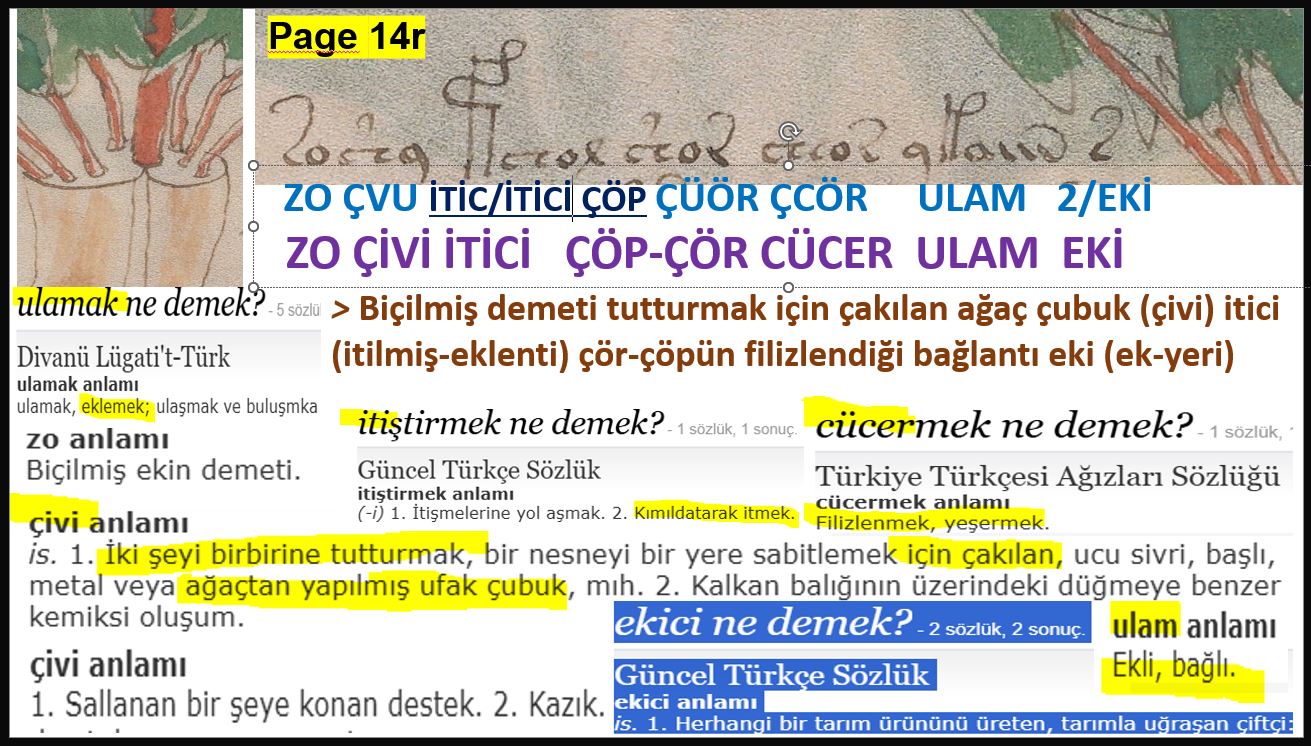ZO ÇİVİ İTİC ÇÖP-ÇÖR CÜCER ULAM 2/EKİ

ZO ÇİVİ İTİC ÇÖP-ÇÖR CÜCER ULAM 2/EKİ
Original-Latin : ZO ÇVU İTİC/İTİCİ ÇÖP ÇÜÖR ÇCÖR ULAM 2/EKİ
Transcript :
Linguistic Commentary on Voynich Manuscript Folio 14r:
On folio 14r, in the first line of the second paragraph, the author has written:
**"ZO ÇVU İTİC/İTİCİ ÇÖP ÇÜÖR ÇCÖR ULAM 2/EKİ"**
This phrase, when transcribed with phonetic proximity as the guiding principle, may be rendered in dictionary-based Turkish as:
**"ZO (ekin demeti) ÇİVİ İTİC ÇÖP-ÇÖR CÜCER ULAM 2/EKİ"**
Analyzing the lexical items in sequence and considering their morphological components, the semantic interpretation of the phrase is as follows:
** "The wooden peg-like stick driven in to hold/fasten the harvested bundle, pushing element (attached-addition joint made by pushing), the connecting joint (junction-area) from which the sticks sprout." **
Linguistic Observations:
1. **The term İTİC/İTİCİ**:
This word denotes the act of one object being affixed to another through applied force — essentially, "to be pushed into place." Its root verb is *İTMEK* ("to push"). Notably, the phonetic and semantic resemblance to the English word *attached* is striking. Given this affinity, and supported by additional linguistic evidence not elaborated here for brevity, it is plausible to hypothesize that the Old Turkic term *İTİC* may have influenced, or been borrowed into, certain Indo-European languages.
2. **Semantic-Visual Alignment**:
The illustration on folio 14r appears to correspond closely with the semantic content of the described phrase. This alignment is noted as a **semantic match between visual and textual elements**, reinforcing the interpretation through multimodal linguistic analysis.
---
Yazar 14r sayfasında ikinci paragrafın ilk satırında şunu yazmış:
"ZO ÇVU İTİC/İTİCİ ÇÖP ÇÜÖR ÇCÖR ULAM 2/EKİ".
Bunu günümüzde şöyle yazabilirdik ki burada transkripsiyona esas olan eşleme kıyaslanan sözcüklerin fonetik değerce yakınlıklarıdır:
"ZO ÇİVİ İTİC ÇÖP-ÇÖR CÜCER ULAM 2/EKİ"
Bu tümcede geçen sözcüklerin aynı sıra ile sözlükteki anlamlarını sözcük eklerini dikkate alarak yine aynı sıralama ile yazsak ortaya şu anlam çıkmaktadır:
"Biçilmiş demeti tutturmak için çakılan ağaç çubuk (çivi) itic (itilerek yapılmış ekleme yeri) çöp-çubukların filizlendiği bağlantı ek-yeri".
Bu açıklamalarda not etmek istediğim birkaç önemli nokta mevcut. Bunlardan ilki burada geçen İTİC/İTİCİ biçiminde yazılan sözcük i"bir şeyin birbaşka şeye itilerek eklenmesi" anlamındadır ve sözcük kökü "İTMEK" (iteklemek) fiilidir. Bu sözcük ile İngilizcedeki "attached" sözcüğü fonetik değer bakımından oldukça yakın ve anlamca da örtüşür durumdadır. Bu sebeple ve burada konudan sapmamak adına detaylandırmayacağım bazı başka dil bilimsel dayanaklarla Eski Türkçedeki İTİC sözcüğünün Hint Avrupa dilleri denilen dillere alıntılanmış olabileceğini düşünmekteyim. Diğer bir önemli nokta ise 14r sayfasında yapılan çizimle burada geçen açıklamanın örtüşüyor olması durumudur. Bunu bir çizim tümce semantik eşleşmesi olarak not etmekteyiz.
